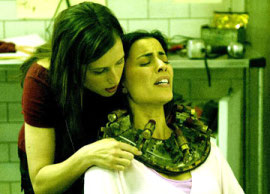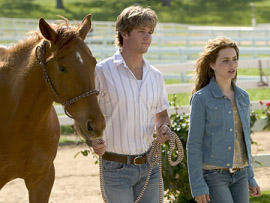 SAW III
SAW III
There's a shot in Saw III - one of the less repellent ones, and one of the few that makes any sense whatsoever - that proves pretty emblematic of the movie as a whole. A middle-aged man, attempting to escape the machinations of the serial killer Jigsaw, runs down a dank hallway and vomits, and as he does, the camera pans down for a close-up of the bile. In a nutshell, that's Saw III - having our faces shoved in puke. (Also blood, entrails, and, in one sequence, pureed pig.) Whatever ultra-violent wit the Saw series may have once boasted is nowhere on display here; the film is 105 minutes of solid torture, both for Jigsaw's hapless victims and for the audience.
Its vile relentlessness might not have been so offensive if the movie didn't keep trying to convince you that it's actually smart. Saw III wraps up with one of those Usual Suspects-y montages in which previous events theoretically tie together in a satisfying "A-ha!" But the "A-ha!" here is more "What the ... ?!?" Somehow, everything you've witnessed now makes less sense than it did before, and the film is already littered with ceaseless flashbacks and impenetrable motivations and impossible coincidences; with its schizoid editing and whirling-dervish camera work, the movie feels like an assault on coherence. Saw III is revolting, and repetitive, and not scary in the least. But with its deliberate humorlessness and hipper-than-thou nihilism, it's worse than just another inevitably crummy horror sequel - it's a big pile of puke.
 CATCH A FIRE
CATCH A FIRE
I'm sure director Phillip Noyce had a lot to contend with during the filming of Catch a Fire: finding ways to make an apartheid drama resonate with contemporary audiences; dramatizing the grimness of political and racial oppression without shirking on visceral thrills; balancing the nightmare of the South Afrikaners' struggle with a measure of hope. Yet couldn't Noyce have taken a moment to fix whatever the hell is going on with Tim Robbins' accent?
Normally, this wouldn't much bother me; a weak accent is a cosmetic annoyance, like an ugly costume or phony old-age make-up. But in Catch a Fire, Robbins, in his role as an implacable South African counter-terrorism agent, is meant to be a rigid bureaucrat, and I couldn't stop giggling at him. Occasionally, his regional dialect is spot-on, but then in his next scene - sometimes in his next line - he'll switch to something vaguely British, or French, or sometimes he'll just chuck the accent altogether. (During a scene alongside his on-screen family, Robbins - honest to God - briefly turns Cockney.) It's a truly bum piece of acting - Robbins' portrayal is as listless as his readings are loony - but truth be told, in about a week, it may well be the only thing I remember about Catch a Fire. The movie isn't bad; it just isn't much of anything.
Detailing the true story of Patrick Chamusso (Derek Luke), a law-abiding foreman turned revolutionary, Catch a Fire has built-in urgency, and Luke turns in a fine, anguished performance. Yet the movie - like Flags of Our Fathers - wears its noble intentions on its sleeve, and the camera pushes itself in too close to the suffering. The images lack the horrific scope, the sense of nationwide outrage, the material demands; it looks and - given the prosaic flatness of Shawn Slovo's dialogue - sounds like a tony yet mediocre TV movie. The only times Catch a Fire catches fire are when the freedom fighters sing their anthems of rebellion and pride - the South Afrikaners' soaring voices exude the passion, indignation, and righteousness that the rest of Noyce's film is sadly lacking.
 FLICKA
FLICKA
In director Michael Mayer's Flicka, an updating of Mary O'Hara's children's classic My Friend Flicka, the screenwriters have turned heroic young Ken into heroic young Katy. But since O'Hara's tale is a love story between an unruly kid and a more unruly horse, gender is mostly irrelevant.
Here's the problem, though. Katy is supposed to be 17 tops. Yet Alison Lohman, who plays her, isn't a convincing 17-year-old. At all. (She was 25 during filming.) With Katy in various stages of sleep-deprivation and hysteria throughout the film, Lohman - with dark circles under her eyes - has been photographed so she looks less 17 than 37, and she's working so hard at acting 17 that everything she does reads as phony. The only way Flicka could conceivably work is with a leading performer whose naturalism either cut through or embraced the movie's inherent corn, but Lohman is the opposite of naturalistic - she chirps and weeps and flails about but doesn't seem to believe in what she's doing, and her every gesture and reading feel calculated within an inch of their lives.
Lohman's failings aren't so pronounced in her scenes with the horse, mostly because we're not paying much attention to her; the film's highlight is a single, magical take of Flicka, with slow, halting steps, inching up to Katy for the first time. But when watching an earnest family flick such as Flicka, I'd rather not spend my time wondering if the leading character's devotion to her stallion is a deeply unhealthy obsession, or if the actress is merely overdoing it. I'd rather not be distracted by her unseemly flirtation with her on-screen brother with the washboard abs (Ryan Kwanten). And I'd rather not be wishing that the studio had waited three or four years before filming, when the leading actress' daughter may have been perfect for their leading actress' role.
 ROVING MARS
ROVING MARS
The latest edu-tainment at the Putnam Museum & IMAX Theatre, a Disney presentation titled Roving Mars, follows the two unmanned, robotic contraptions - Spirit and Opportunity - that first explored and analyzed the Red Planet in 2004, recording images that suggested that riverbeds (and, implicity, life) were once part of Mars' geologic make-up. Yet there was no way to actually film much of this magnificent endeavor, so most of the robots' mission and findings, here, have been replicated via computer animation. Suffice it to say that even the youngest Roving Mars viewers might not be fooled by the ruse - at times, the 50-minute film looks as artificial as The Ant Bully - and scientific tenets are oftentimes blithely ignored; when traversing the heavens, are spacecrafts really this noisy? (Star Wars' space battles certainly aren't silent, either, but unlike Roving Mars, George Lucas' opus isn't "presented as a public service by Lockheed Martin in collaboration with NASA.")
Ah, but what glorious noise! The awesome, seat-shaking sound effects nullify your complaints about their appropriateness, and the visuals, though obvious replications, often display a thrilling grandeur - the scenes of the 'bots making their bouncy landings on Mars are superbly designed. Roving Mars is filled with pleasures - NASA scientist Stephen Squyres nattering away like a caffeinated Martin Scorsese, Philip Glass' score providing extra narrative thrust - and kids will likely be charmed by the expected Disney anthropomorphism; Spirit, the "elder" of the two childlike robots, is referred to as "the troublesome firstborn," while its sibling is called "little miss perfect." Expect your kids to begin denigrating each other with "You're such a Spirit!" or "Shut up, Opportunity!" any day now.










